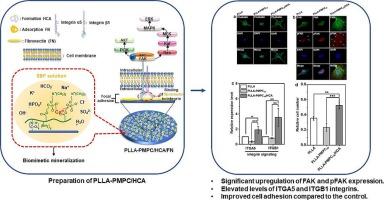聚(2-甲基丙烯酰氧乙基磷胆碱)偶联在聚l -乳酸表面的仿生矿化及其对MG-63细胞行为影响的研究
IF 5.9
3区 工程技术
Q1 CHEMISTRY, MULTIDISCIPLINARY
Journal of Industrial and Engineering Chemistry
Pub Date : 2025-05-11
DOI:10.1016/j.jiec.2025.05.010
引用次数: 0
摘要
本研究的目的是将磷酸基团引入骨科高分子材料,使其在与体液接触时吸附钙离子并形成羟基碳酸盐磷灰石(HCA),从而促进仿生矿化。为此,将聚l -乳酸(PLLA)盘与聚(2-甲基丙烯酰氧乙基磷酸胆碱-co-2-氨基乙基甲基丙烯酸盐盐)(PLLA/PMPC)偶联,引入磷酸基团,在PLLA表面提供矿化位点。用NaOH和乙醇处理PLLA圆盘,在表面生成OH和COOH基团,然后与PMPC的胺基进行缩合反应。为了进行仿生矿化,将PLLA/PMPC盘浸泡在模拟体液(SBF)中14天,诱导HCA形成(PLLA-PMPC/HCA)。采用傅里叶变换红外光谱(FTIR)、x射线光电子能谱(XPS)、扫描电镜(SEM)、接触角测量和x射线衍射(XRD)对表面改性进行了分析。体外实验表明,与对照组和pla - pmpc片相比,pla - pmpc /HCA片增强了MG-63细胞的粘附和增殖。发现HCA的形成有助于纤维连接蛋白的吸附,促进局灶粘连。pla - pmpc /HCA盘促进局灶黏着整合素(α5和β1)和FAK表达增加,诱导FAK- mapk和PI3K-AKT通路下游信号通路增殖。本文章由计算机程序翻译,如有差异,请以英文原文为准。

Investigation on biomimetic mineralization and its effect on MG-63 cell behavior on poly L-lactic acid surfaces through poly (2-methacryloyloxyethyl phosphorylcholine) conjugation
The purpose of this study was to introduce phosphate groups into orthopedic polymeric material, so that they adsorb calcium ions when in contact with body fluids and form hydroxycarbonate apatite (HCA), thereby encouraging biomimetic mineralization. To this end, poly L-lactic acid (PLLA) discs were conjugated with poly (2-methacryloyloxyethyl phosphorylcholine-co-2-aminoethyl methacrylate hydrochloride) (PLLA/PMPC) to introduce phosphate groups to provide mineralization sites on the surface of PLLA. PLLA discs were treated with NaOH and ethanol to create OH and COOH groups on the surface, then coupled with the amine groups of PMPC in a condensation reaction. For biomimetic mineralization, PLLA/PMPC discs were immersed in simulated body fluid (SBF) for 14 days to induce HCA formation (PLLA-PMPC/HCA). The surface modification was analyzed using Fourier-transform infrared spectroscopy (FTIR), X-ray photoelectron spectroscopy (XPS), scanning electron microscopy (SEM), contact angle measurements, and X-ray Diffraction (XRD). In vitro experiments showed PLLA-PMPC/HCA discs enhanced adhesion and proliferation of MG-63 cells compared to control and PLLA-PMPC discs. HCA formation was found to contribute to fibronectin adsorption, promoting focal adhesion. PLLA-PMPC/HCA discs contributed to increased integrins (α5 and β1) and FAK expression for focal adhesion and induced downstream signaling of the FAK-MAPK and PI3K-AKT pathways for proliferation.
求助全文
通过发布文献求助,成功后即可免费获取论文全文。
去求助
来源期刊
CiteScore
10.40
自引率
6.60%
发文量
639
审稿时长
29 days
期刊介绍:
Journal of Industrial and Engineering Chemistry is published monthly in English by the Korean Society of Industrial and Engineering Chemistry. JIEC brings together multidisciplinary interests in one journal and is to disseminate information on all aspects of research and development in industrial and engineering chemistry. Contributions in the form of research articles, short communications, notes and reviews are considered for publication. The editors welcome original contributions that have not been and are not to be published elsewhere. Instruction to authors and a manuscript submissions form are printed at the end of each issue. Bulk reprints of individual articles can be ordered. This publication is partially supported by Korea Research Foundation and the Korean Federation of Science and Technology Societies.

 求助内容:
求助内容: 应助结果提醒方式:
应助结果提醒方式:


